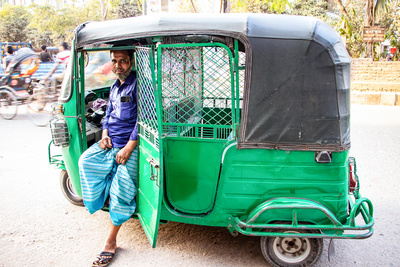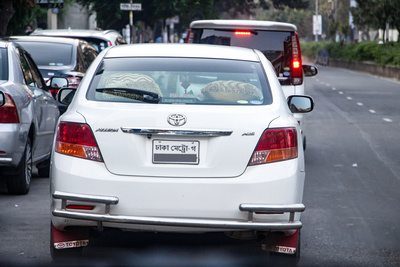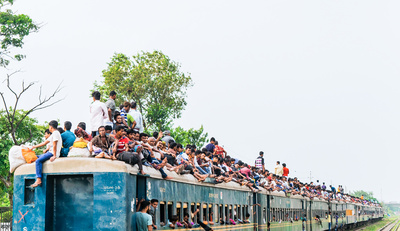

日本貿易会月報オンライン
MENU
バングラデシュの交通事情変革期
2022年4月号(No.806)
Introduction
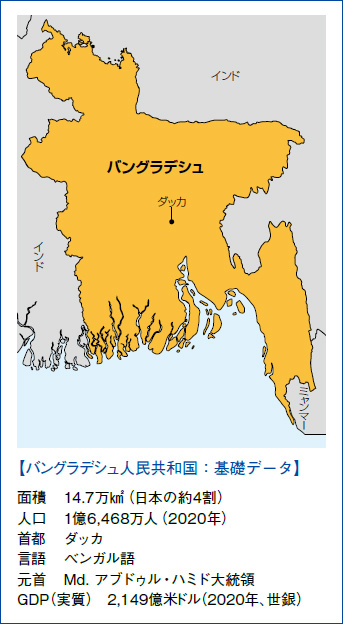
I have been working in Mitsui Bangladesh for more than 22 years. In the last 22 years there has been great economic development of Bangladesh with a GDP growth rate of 5-6% year on year basis. I have been fortunate enough to witness tremendous positive changes both in economic and social development aspects. However, there has not been much of improvement in transport sector which remained a challenge for Dhaka city dwellers to lead comfortable life! I have had the opportunity to travel across the world on business including my 2 years journey in Japan as trainee. Due to such overseas exposure, the interesting unique points of Dhaka’s transport sector quickly popup in the mind.
Dhaka, the capital of Bangladesh, is one of the most densely populated cities in the world. Dhaka emerged as a cosmopolitan city even before British colony. The current population is more than 22 million while the land size is just 306 square km! Therefore, it is extremely congested city and the service of public transport in Dhaka City is abysmal. Today I would like to introduce various modes of transport being used in Bangladesh.
First let me introduce Rickshaw.
How much do you know about Rickshaw in Dhaka?
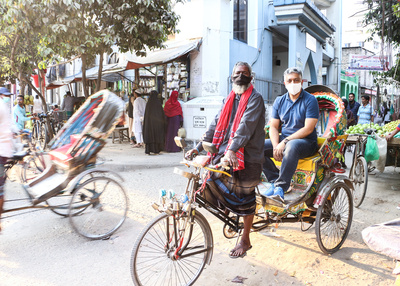
While riding rickshaw
Bicycle-Rickshaw is one of the rare modes of transport in this era. Surprisingly, hundreds of thousands of rickshaws are plying on the roads of Dhaka, it is one of the main modes of transport. I sometimes also use rickshaw for short distance. Rickshaw ride is comfortable if you are habituated, its eco-friendly and cheap. For me, the best part is you can see the sky while riding on a rickshaw! For foreigners it takes time to get used to of it because of uncomfortable seat, and sometimes one rickshaw is colliding with other. It is not rare to see the foreigners especially Europeans are using rickshaw in Dhaka. I was talking to a European couple as they often use rickshaw despite having own cars. Both replied, when ride on rickshaw, they feel like they are traveling like tourists and relaxing… It was very interesting to hear such a reaction!
However, the government has banned rickshaw on many roads of Dhaka city because it creates traffic jam and compels other vehicles to move slow. Very few roads are having dedicated lane for rickshaw. The government cannot totally ban rickshaw as it still generates large employment.
When I was university student, with my friends we tried to drive rickshaw out of fun, then realized that driving rickshaw through leg peddles with 2 passengers on the back seats requires heavy energy and patience. We wondered how the rickshaw pullers are driving it everyday and earning livelihood. Yet seeing their smiling faces, they seem to be happy people...
The word “rickshaw” is derived from “人力車”. Various paintings made on Bangladeshi rickshaw for decoration is also famous, there were exhibitions of such paining in Japan in the past. One rickshaw painting is always exhibited in Fukuoka Asian Art Museum.
3-wheeler: CNG Rickshaw
CNG run 3-wheeler: In Dhaka, 3-wheeler run by CNG is very popular, it is like Tuk-tuk in Thailand. The fuel is CNG, so it is being called as “CNG Rickshaw”. The fare is based on negotiation, there is taximeter installed but no driver follows it. Due to heavy traffic jam, using taximeter is not economically viable for drivers. CNG rickshaw is very suited for narrow and crowded streets to run because it can move with speed, thus popular. CNG rickshaws are painted in green color to signify that its eco-friendly. However, this Tuk-tuk like 3-wheeler has a unique component, which is “metal net” - covering the rickshaw to avoid being snatched in the night, only to limited number of areas though. Any foreigner first time riding on the CNG rickshaw, will not be able to figure out why the clumsy metal net is used!
How is passenger car?
If you come to Dhaka, you will feel that large number of cars are moving on the roads. The fact is the opposite, the cars being imported is very small in number! As the city has limited numbers of roads, even small number of cars creates the roads congested, people misunderstand the fact otherwise. Bangladesh imports around 40,000 cars per annum, 80% is Japanese secondhand cars. As the secondhand cars are directly imported in the condition of as it is, sometimes the car navigator app remains installed. If you get on such car for the first time, you will feel you are in Japan because the navigator will suddenly speak up saying “[目的地を設定してください。]”!
You may ask why import of cars is such small in number, despite the GDP per capita is US$2,200 which is little higher than India. Do you know the reason? It is mainly for high import tax, it varies from 130% to 800% depending on the engine size, isn’t it unbelievable? The lowest 130% is applicable for 1,000-1,500 CC.
TOYOTA has the biggest market share, according to market insider, more than 70% market share, mostly secondhand cars.
In case of passenger cars also there is a unique feature, an extra metal bumper to avoid light damages from rickshaw or CNG rickshaw. Probably no other country has this. As you can see in the photo, there is additional bumper attached in the back of the car. Often rickshaw makes light collision with car. So, to protect such kind of light damage or scratch on the car body, bumper is a creative solution, isn’t it?
Bangladesh government is now framing up a modern automobile policy in where the import tariff structure is being considered and local assembly and production will be encouraged. The market potential of 165 million people is simply immense!
How about public transport - bus or train?
The city bus services are not good, very old, unclean, and crowded with inconvenient routes. I used the bus service a lot during my studentship, I have not availed bus services more than 10 years. The intra-city train services are also inconvenient and crowded. Of course, not as crowded as the photo is. The photo of crowded train is quite famous. This is a photo during the Eid holidays. Eid is the largest Muslim festival, and all the people go back to their hometowns. At that time the train turns super overcrowded.
Any ride sharing service?
There are many ride sharing services including Uber. In addition to uber, there are local ride sharing companies such as Pathao. Uber has been successful in providing car service while local ride sharing companies like Pathao are successful in motorbike sharing services. The city which has so much of traffic jam and hours are spent on the road every day, motorbike should be an ideal solution. However, high import tariff restricted the increase of motorbike as a solution. The recently framed two-wheeler policy of government has encouraged local manufacturing and making the motorbikes more affordable. Female motorbike riders are growing both for personal and sharing purpose.
Ride sharing services especially motorbike has brought lot of comfort and convenience to city dwellers. I have been using uber car services and found the service is good though sometimes arrival of car is 15-30 minutes delay which is within acceptable range here.
Jay Walking: a rare practice
It doesn’t exist in the developed countries for sure but exists in Dhaka. It is jay walking, while the transports like car is moving, the pedestrians keep walking or crossing the road disregarding traffic signal or rules. There are very few automatic traffic light signals in Dhaka, so pedestrians are used to of such jay walking, causing fatalities sometimes. Expect more education on road manner and discipline.
Lack of infrastructure, poor discipline and weak coordination in transport have been causing large negative impact in economic growth. It is also challenging to bring solutions in such a busy city of 22 million residents. It takes time, experts think that government should religiously pursue decentralization instead of concentrating everything in Dhaka to disperse the population across the country. Currently, government is relentlessly pursuing various construction of flyovers, u loops, elevated expressway etc. to build sustainable infrastructure. The government is also taking ODA loan from Japan for establishing metro rail lines.
MRT (Mass Rapid Transit)
5 metro rail lines, and 1 bus rapid transit are in the revised strategic transport plan, which is the master plan of transport system of the city. Among those, MRT line number 6 funded by Japanese ODA loan will be launched by the end of this calendar year. The construction of next two lines are targeted by 2026 and 2028 with the help of Japanese ODA loan. These are expected to bring dramatic changes of people’s lifestyle. Like all the residents of Dhaka city, I am also looking forward to experiencing the metro rail lines in the beloved city.
Concluding Remarks
It is quite challenging to keep up the development of transport system with the tremendous growth of economy. In 2026, Bangladesh is expected to graduate from LDC countries, obviously new challenges will appear. According to the study of HSBC, Bangladesh economy will become 26th largest economies in the world in 2030. The support from Japanese government to Bangladesh will remain instrumental. The development of Matarbari island will act as game changer. Bangladesh, a Japanophilia country, is having growing appetite for expansion of business with Japanese companies. The joint effort of public and private sector will achieve the envisaged development. 10 years from now, would like to see the rickshaws are disappeared, rickshaw pullers have transformed their job to motorbike ride sharing services or three-wheelers, no metal net in the CNG rickshaw and no extra bumper in the car. We also anticipate locally produced motorbikes and cars will bring complete change of business environment along with MRT lines.
